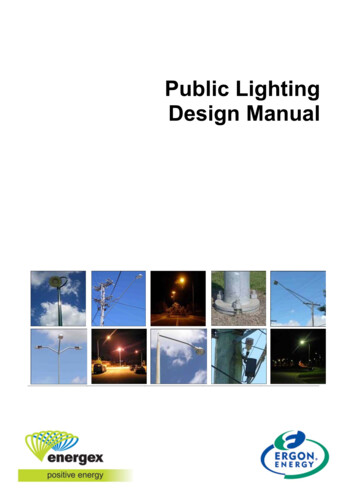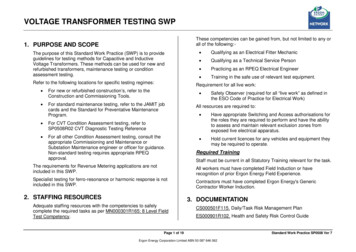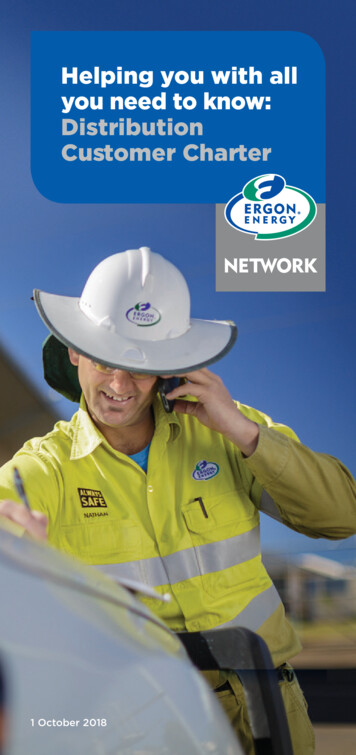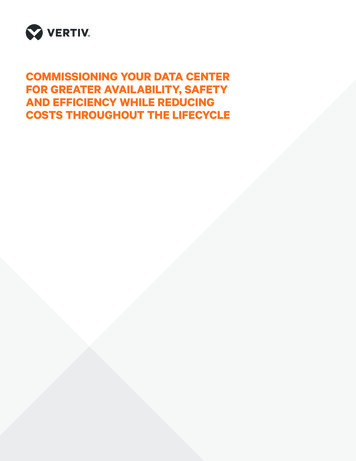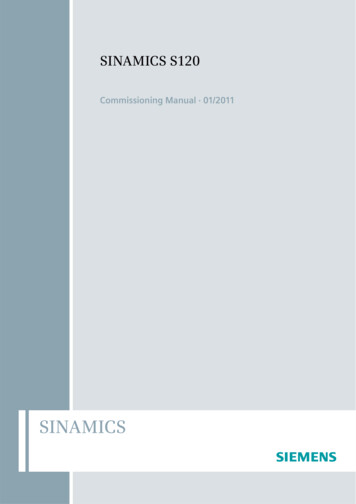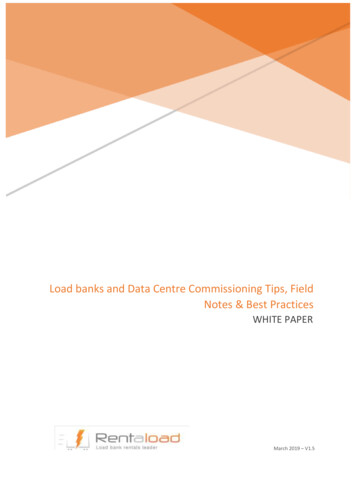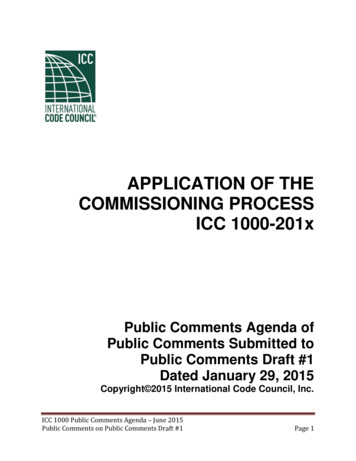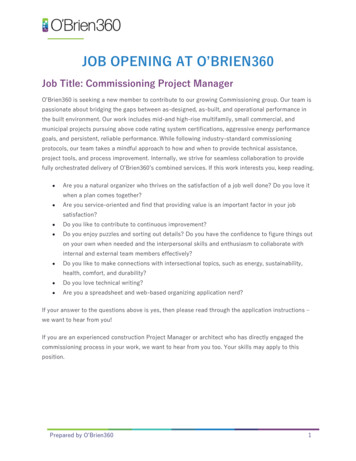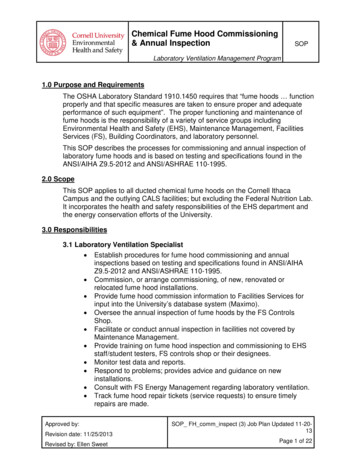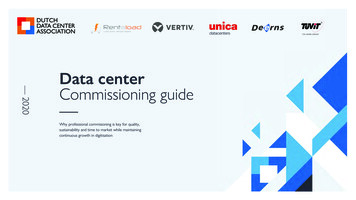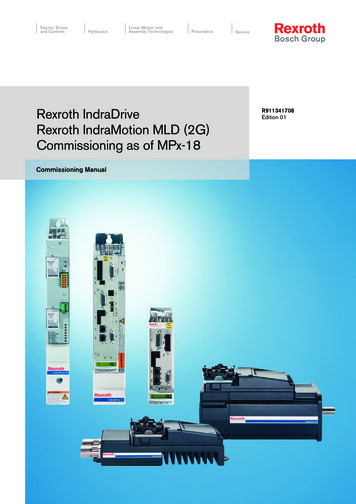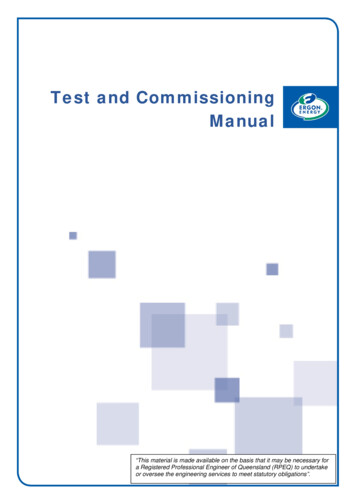
Transcription
Test and CommissioningManual“This material is made available on the basis that it may be necessary fora Registered Professional Engineer of Queensland (RPEQ) to undertakeor oversee the engineering services to meet statutory obligations”.
Test and Commissioning ManualThis material is made available on the basis that it may be necessary for a RegisteredProfessional Engineer of Queensland (RPEQ) to undertake or oversee the engineering servicesto meet statutory obligations.Ergon Energy makes no representations, express or implied, as to the accuracy of thedocuments provided and accepts no liability howsoever arising for any loss resulting from theuse of the documents or reliance placed on them.The recipient agrees to indemnify Ergon Energy and keep it indemnified against any liability forany losses (including liabilities of the recipient to third parties), costs and expenses arising out ofthe use or reliance on the documents by the recipient.The documents provided are to be used as a guide only. Subject to any other statutoryobligation, to the extent practical, the recipient agrees to use reasonable endeavours to notifyErgon Energy of any errors or omissions it becomes aware of in the documents to enablecorrection/updating.iErgon Energy Corporation Limited ABN 50 087 646 062Reference MN000301R171 Ver 2
Test and Commissioning ManualTable of Contents1.2.3.4.5.6.7.Purpose and Scope . 1Definitions, Abbreviations and Acronyms . 1References. 4Role and Responsibilities of the Commissioning Officer / Engineer. 4The Commissioning Process . 6Commissioning Staging Plan and Commissioning Outage Plan . 6Handovers. 77.1. Design Handover . 77.2. Construction Handover . 77.3. Vendor Handover . 77.4. Testing Handover . 88.Drawing Management . 89.Submission of Application for Work Requests and System Outages . 910. Commissioning Testing . 910.1.10.2.10.3.10.4.10.5.10.6.Primary Plant Testing . 10Secondary Systems Testing . 10Substation Communications System Testing . 11Revenue and Statistical Metering Testing. 11Substation Miscellaneous System Testing. 11Test Result Assessment . 1111. Reporting of Plant, Construction and Design Defects during theCommissioning Process . 1112. Pre-Connection Hold Point. 1213. Commissioning Authority for Energising Electrical Plant . 1214. Customer Authority to Energise Customer Owned Plant . 1315. Commissioning and Decommissioning Notices . 1316. Storage of Test Results . 1317. Post Commissioning Closeout . 1318. Authorisation and Approval of Commissioning Documentation. 14A1. Annex 1 – Commissioning Process Flowchart . 16A2. Annex 2 – Commissioning Process Inputs and Outputs . 17A3. Annex 3 – Terms and Conditions of Use of Ergon Energy DevelopedAutomated Test Reporting Tools, Standard Work Practices and StandardProtection Relay Test Plans . 18A4. Annex 4 – Testing Coodination with Major Customers . 19A5. Annex 5 – Additional Requirements For Generators. 20iiErgon Energy Corporation Limited ABN 50 087 646 062Reference MN000301R171 Ver 2
Test and Commissioning Manual1. PURPOSE AND SCOPEThis document defines the commissioning process in the context of the Ergon Energy projectdelivery process. This manual is applicable for all substation projects regardless of the deliverymode (internal/external).It is not the intention of this manual to repeat, nor supersede information and guidelines which aredetailed in the Ergon Energy Standard Work Practices, Reference Documents or Inspection andTest Plans. If a conflict exists between this document and the Ergon Energy published StandardWork Practice, Reference Document or ITP then clarification from the Commissioning andMaintenance Group shall be obtained.The Scope of this manual includes:i.Define the roles and responsibilities of the Test and Commissioning Officer/Engineer duringthe development and implementation phases of a project.ii.Define the required deliverables for the Test and Commissioning Team during projectdevelopment and implementation phases.iii.Define the required quality assurance documentation that will be completed during projectimplementation.The information provided in this manual has been written with the intent of safely delivering the testand commissioning portion of Ergon Energy projects. The definitions and processes presented inthis manual have been written with a focus on test and commissioning works and do not cover norattempt to cover the definitions or processes of other project delivery groups. Where there existsuncertainty in the interpretation of the material presented within this document the reader shouldalways seek clarification from the assigned Commissioning Engineer/Officer.2. DEFINITIONS, ABBREVIATIONS AND ACRONYMSThe following terms and acronyms have been defined to provide clarity and consistency duringcommissioning activities.Commissioning Authority to Energise: the Commissioning Authority for Energising ElectricalPlant Form (MN000301F174) is used to signify the completion of three critical stages of thecommissioning process. The first section of this document is signed by the Testing Officerresponsible for Site Integration Testing (SIT) to signify that all site integration testing has beensuccessfully completed. The next section is signed and issued by the Project Manager to theCommissioning Officer/Engineer to provide clearance that all required prerequisites have been metto allow the plant to be energised. The final section is signed by the CommissioningOfficer/Engineer to provide final clearance to energise the plant. This section also lists alloutstanding items affecting network operation and/or maintenance activities as well as anyadditional testing required before the plant is released for normal operation.Commissioning Co-ordination Program: is a detailed technical document which specifies therequired steps to be performed on site to provide a final audit check of critical operations andfunctions. Under the Commissioning Co-ordination Program all new plant/systems will beintegrated and tested into the operational network.Commissioning Officer/Engineer: is an experienced engineer or technician appointed to coordinate and control the testing and commissioning of new or refurbished plant and/or systems.The Ergon Energy P53 Operate the Network Enterprise Process defines this role as theCommissioning Co-ordinator. Note that portions of the Commissioning Officer/Engineer role fulfilErgon Energy’s non-delegable responsibility under the Electrical Safety Act to ensure that plantand systems are tested appropriately prior to energisation and cannot be fulfilled by a contractor.Commissioning Outage Plan: details primary plant and secondary system outages and switchingrequirements to achieve the commissioning outages as described in the Commissioning StagingPlan.Page 1 of 22Ergon Energy Corporation Limited ABN 50 087 646 062Reference MN000301R171 Ver 2
Test and Commissioning ManualCommissioning Schedule: is a time based representation of the tasks required to complete thecommissioning works including the resources required to perform these tasks. The CommissioningSchedule forms part of the overall project schedule.Commissioning Stage: is defined as the works portion which progress a primary plant item orsecondary system from manufacturers testing through to system integration and finalcommissioning testing. In general, a commissioning stage requires that all five phases of testing besuccessfully completed culminating in the successful energisation of new plant or system into theErgon Energy network.Commissioning Staging Plan: is a plan developed by the Commissioning Officer/Engineer whichdetails the proposed substation, distribution and transmission/sub-transmission primary plantconfigurations during each of the proposed commissioning stages. This plan is developed to allowall key stakeholders to understand, review and comment on proposed staging during the projectdevelopment phase.Construction Release: for the purpose of test and commissioning the Construction Release Form(MN000301F175) is used to provide a clear delineation between the completion of constructionactivities and testing phases. This form is completed and signed by the officer responsible forconstruction to signify that construction activities for the listed plant have been completed inaccordance with the quality control systems specified in the construction manual and that allpersonnel involved with the construction have surrendered access to the equipment. This cleardelineation is required to allow testing activities to be safely performed and to ensure that testedplant is not compromised by unauthorised access.Testing Phase Release: the Testing Phase Release Form (MN000301F183) is used to provideclear delineation of a testing phase from subsequent phases. This form is to be completedwhenever handover of a testing phase to a different party is carried out. The form is to be signedby the officer responsible for the testing phase to signify that testing activities associated with thelisted phase have been completed and that all personnel involved with this testing havesurrendered access to the equipment.Development Phase of a Project: The Project Development Phase is initiated on receipt of theProject Initiation Advice and is the time in which the detailed project planning is performed toproduce a project plan. During this phase, as part of the high level design performed by the designgroup, the commissioning officer/engineer will develop a commissioning staging plan andcommissioning schedule. The staging plan will be used to ensure that staged design requirementsare identified and that the final design outcomes reflect the need for commissioning staging. Thecommissioning schedule will be used by project manager to produce the Gate 3 Estimate (G3E) forcustomer approval.Implementation Phase of Project: The Project Implementation Phase commences once Gate 3Approval has been achieved. During this phase the construction and test and commissioningactivities are performed. The Implementation Phase ends on achievement of the Certificate ofPractical Completion (CPC) milestone.Factory Acceptance Testing (FAT): is defined as the Testing Phase performed by themanufacturer on an item of plant or equipment to prove that the item operates in accordance withits design specifications. Factory Acceptance Testing is commonly, but need not be, performed atthe place of manufacture prior to delivery of the plant or equipment.In cases where the piece of equipment under test is comprised of a number of subsystems orcomponents then FAT may include the testing of individual components or of the system as awhole.Inspection and Test Plan (ITP): is a Quality Control document which is used to specify the testingrequirements for a particular testing phase and plant/system item. The ITP is a high level technicaldocument which specifies test types which will be performed and is used in conjunction with therelevant test report documentation.Page 2 of 22Ergon Energy Corporation Limited ABN 50 087 646 062Reference MN000301R171 Ver 2
Test and Commissioning ManualMaintenance Acceptance Criteria (MAC): is a joint workings document developed to define plantcondition acceptance criteria. The MAC is used to evaluate substation and distribution plantcondition and defines test acceptance criteria.Post-Energisation Testing: is defined as the Testing Phase required to confirm that criticalsystem components are operating as per design requirements. This type of testing is generallycovered by a series of on-load tests to confirm system component operability and stability.Pre-Connection Hold Point: is defined as the point in time in which plant transitions from beingunder general access to requiring High Voltage Isolation and Access procedures to be followed inaccordance P53 Operate the Network Enterprise Process.Pre-Energisation Testing: is defined as the Testing Phase required to provide final confirmationthat the system is safe to be energised. Pre-energisation testing can only be performed once theitem of plant or equipment has successfully passed SITProject Manager: is the person assigned with the accountability for overall delivery of a project. Asthe responsible person for project delivery, the project manager must be included in all decisionmaking processes that have a material effect on the project schedule, cost, quality or scope.Site Acceptance Testing (SAT): is defined as the Testing Phase performed at the final installationsite of a piece of plant or equipment to prove that the item meets, within an acceptable level of risk,it’s design specifications. This type of testing is required to ensure that no damage has resultedfrom the plant or equipment being transported or reassembled on site.Site Integration Testing (SIT): is defined as the Testing Phase performed on site to prove that apiece of plant or equipment is correctly connected and integrated into the site to form a completeoperational system.Whilst Site Integration Testing proves that plant and secondary systems operate correctly as anintegrated system, for commissioning purposes, the SIT component only provides integrationtesting of plant and systems not in service. Proof of system integration functionality with in serviceplant and/or systems will be performed during Pre-energisation testing under the control of aCommissioning Co-ordination Program.Standard Work Practice (SWP): is a Quality Control document developed by Ergon Energy whichdetails the requirements and methodology to be followed when performing plant/system testing.Test Report: is an approved Quality Control document used to record test result information.Testing Phase: is defined as set or suite of tests designed to prove, within an acceptable level ofrisk, that a plant item or system meets design specifications. For Ergon Energy commissioningpurposes five phases have been defined, these being Factory Acceptance Testing (FAT), SiteAcceptance Testing (SAT), Site Integration Testing (SIT), Pre-Energisation Testing and PostEnergisation Testing. Note that these five phases do not include testing prior to commissioningsuch as type tests, routine tests or construction testing.Validation: Inspection, testing, measurement, simulations and audits to confirm that the installedplant and equipment and the system design is fit for the intended purpose and meets all regulatoryrequirements and the appropriate standards.Verification: Inspection and testing to confirm that the installed plant and equipment complies withthe system design.Works Portion: is any work performed by an entity to achieve an objective. This includes worksperformed under P53 procedures. Works Portions are commonly used to break down complex orlengthy projects in manageable components. Often a Works Portion will align with aCommissioning Phase.Under Direction: When a task or work is performed under direction the entity providing directiondoes not assume responsibility for the safety obligations of those performing the works. It remainsthe obligation of the entity performing the works to ensure that all works are completed inaccordance with approved work practices and risk management strategies.Page 3 of 22Ergon Energy Corporation Limited ABN 50 087 646 062Reference MN000301R171 Ver 2
Test and Commissioning Manual3. REFERENCESMN000301F123. Construction Safety Clearance – High Voltage Apparatus (Form)MN000301F174. Commissioning Authority for Energising Electrical Plant (Form)MN000301F175. Construction Release (Form)MN000301F176. Customer Authority to Energise Customer Owned Electrical Plant (Form)MN000301F183. Testing Phase Release (Form)MN000301R165. 8 Level Field Test Competency (Reference)STNW1160. Maintenance Acceptance Criteria (Standard)P53 Operate the Network (Enterprise Process)4. ROLE AND RESPONSIBILITIES OF THE COMMISSIONING OFFICER /ENGINEERThe role of the Commissioning Officer/Engineer with respect to the delivery of Ergon Energyprojects is to provide technical support and advice for the Project Manager regarding thecommissioning phases of the project and to carry out the project commissioning responsibilitiesdescribed in this section.Note that the Project Manager is not required to have detailed technical knowledge ofcommissioning works and is reliant on regular briefings from the Commissioning Officer/Engineerto keep up to date with commissioning activities and progress. Where any potential impact onproject cost, quality (scope) or time (schedule) becomes evident to the CommissioningOfficer/Engineer, the Project Manager shall be notified as soon as possible so that project impactand risk can be evaluated. Any decision that alters project cost, quality (scope) or time (schedule)shall be made by the Project Manager. This decision should be made in consultation with impactedparties.The Commissioning Officer/Engineer is responsible for:a)Development of a Commissioning Staging Plan– a Commissioning Staging Plan will bedeveloped by the Commissioning Officer/Engineer during the project development phase.The staging plan will detail the proposed substation, distribution and transmission/subtransmission primary plant configurations during each of the proposed commissioningstages.The commissioning staging information is to be used when producing design specificationsto ensure that all primary plant, secondary systems and protection systems designs areproduced for each of the proposed commissioning stages. Once developed, theCommissioning Staging Plan will be reviewed and modified as necessary to gain approvalfrom the project Key Stakeholders.The Commissioning Staging Plan is the overarching or high level document which describesthe proposed commissioning staging. It is supported by the more specific and detailedCommissioning Co-Ordination Programs as described below.As the project progresses towards its commissioning stage/s the Commissioning StagingPlan will be further refined by the Commissioning Officer/Engineer to include and reflectmore detailed information as this information becomes available.An example of a Commissioning Staging Plan is available on the Commissioning andMaintenance Beacon Site.b)Development of a Commissioning Outage Plan – the Commissioning Outage Plan willprovide a high level detail of the primary plant and secondary system outages required toPage 4 of 22Ergon Energy Corporation Limited ABN 50 087 646 062Reference MN000301R171 Ver 2
Test and Commissioning Manualachieve the planned commissioning staging for the project. Close consultation with PowerSystem Management and the Regional Asset Manager is required during development of theoutage plan to ensure network risks are managed appropriately during commissioning.c)Production of Inspection and Test Plans (ITPs) and Test Reports – these are qualitycontrol documents which specify the testing requirements for primary plant and secondarysystems. Ergon Energy has developed a set of tools which automatically produceengineering approved standard ITPs and Test Reports for primary plant and secondarysystem Testing and Commissioning Works – refer to Section 10 for further information.The Ergon Energy assigned Commissioning Officer/Engineer will be responsible forproducing the ITPs and Test Reports for each of the commissioning stages at the start of theproject implementation phase. Where non-standard ITPs are required these ITPs must beapproved in accordance with Section 18, “Authorisation and Approval of CommissioningDocumentation” of this document.In consultation with the Project Manager, the Commissioning Officer/Engineer may requestadditional testing to more effectively manage project risk – for example partial dischargetesting of an MV switchboard in a transportable building may be carried out initially when theswitchgear is installed in the building (in order to detect defects in the switchboard as earlyas possible) and again when the building is installed on site (in order to detect transportdamage).Where contractors are performing test and commissioning works the CommissioningOfficer/Engineer will forward the prepared ITPs and test reports to the project manager whowill pass these documents onto the contractor test and commissioning representative.d)e)Development of a Commissioning Co-ordination Program – the Commissioning Coordination Program is a detailed technical document produced by the CommissioningOfficer/Engineer during the project implementation phase to detail the required steps to beperformed on site to energise or de-energise substation plant. This document will detail thefollowing information:1.A high level overview of secondary systems isolation requirements.2.A high level overview of works to be performed.3.A works co-ordination programme detailing the order in which works need to beundertaken to commission the plant and secondary systems. The order of worksdetailed in the commissioning co-ordination program will reflect and align with thecommissioning outages.4.A high level overview of secondary systems testing and primary injection requirementsto prove system functionality and stability pre plant energisation. Where new workinterfaces to existing plant, all secondary circuitry testing shall be carried out to knownand proven points, i.e. there shall be an overlap in the testing. All protection systemsshould be in service for energising of new plant.5.Requirements for temporary protection systems or wiring (for example if appropriateprotection functionality cannot be maintained during commissioning or construction).6.Requirements for commissioning setting groups (for example a non-directional distancezone may be required until relay directionality can be confirmed).7.Phasing checks required.8.On-load or post-energisation checks required.Developing the Commissioning Schedule – the Commissioning Officer/Engineer isrequired to provide SME input to the Project Manager to ensure scheduling and sequencingof commissioning activities is incorporated appropriately into the overall project schedule.Page 5 of 22Ergon Energy Corporation Limited ABN 50 087 646 062Reference MN000301R171 Ver 2
Test and Commissioning Manual5. THE COMMISSIONING PROCESSThe Commissioning Process is shown in the flowchart provided in Annex 1. This process has beendivided into the Project Development and Implementation Phases to achieve alignment with theproject management phases of the project lifecycle. Within the project implementation phase thecommissioning activities have been further broken down into the commissioning phases to identifythe divisible portions of the test and commissioning lifecycle. The major components of thecommissioning activities in relation to their project lifecycle phases are further detailed in thefollowing sections of this document.6. COMMISSIONING STAGING PLAN AND COMMISSIONING OUTAGEPLANAt the project development phase of the project lifecycle the project objectives will be fully definedhowever the project scope will not be clear. Until a Commissioning Staging Plan has beendeveloped and approved the project scope cannot be fully determined. In order for theCommissioning Officer/Engineer to develop a staging plan the Project Manager must provide thefollowing information to the Commissioning Officer/Engineer:a)A single line protection diagram showing the final plant configurations for all effectedsubstations as defined by the project objectives.b)A general arrangement drawing showing the final plant layout for all effected substations asdefined by the project objectives.c)A proposed transmission and distribution feeder arrangement layout for all effectedsubstations as defined by the project objectives.Once the above information has been provided, the Commissioning Officer/Engineer will develop aCommissioning Staging Plan. The staging plan will detail the proposed substation, distribution andtransmission/sub-transmission primary plant configurations during each of the requiredcommissioning stages. Once developed, the project manager will arrange for a meeting to facilitatea review of the Commissioning Staging Plan with the following key stakeholders: Project Design Manager – for confirmation and approval that the primary plant andsecondary systems infrastructure can be constructed to meet the Commissioning StagingPlan requirements and that all designs will be provided for each of the proposedcommissioning stages. Protection Design Engineer – for confirmation and approval that all primary plant can beadequately protected during all proposed commissioning stages. Regional Asset Manager – for confirmation and approval that network risk associated withthe commissioning staging is acceptable to the Asset Manager. Lines / Customer Delivery Manager - for confirmation and approval that network risk andcustomer impacts associated with the commissioning staging is acceptable. Network Operations and Outage Co-ordination Groups – for confirmation and approval thatthe proposed commissioning staging and required outages to achieve this staging will besupported by these groups and that any operational concerns have been identified andconveyed to the commissioning officer/engineer. Project Manager – for approval of the commissioning staging including resource and timerequirements to execute these plans.On completion of the review stakeholder approval of the Commissioning Staging Plan will beformalised by signing the approvals section of the Commissioning Staging Plan document.Once finalised, the requirements of the Commissioning Staging Plan are to be incorporated intothe Commissioning Outage Plan. The Commissioning Outage Plan will continue to be modified andupdated in the implementation phase as detailed design information becomes available.Page 6 of 22Ergon Energy Corporation Limited ABN 50 087 646 062Reference MN000301R171 Ver 2
Test and Commissioning Manual7. HANDOVERS7.1. Design HandoverAt least six weeks prior to the start of execution of each of the commissioning stages the ProjectManager will call for a handover meeting. The purpose of the handover meeting is to ensure thatall Stakeholders receive the required documentation to allow the Commissioning Stage to proceed.Key handover documentation will include: A complete Secondary System Design for the upcoming stage of work. This will include acomplete set of approved Secondary System Design Drawings, Remote Terminal Unit (RTU)Configuration Files, an RTU SCADA Points Test List and RTU Logic Drawings. A complete Protection System Design for the upcoming stage of works. This will include anapproved set of all Protection Relay Setting Files, Protection Setting Requests (PSRs) andProtection Relay Logic Drawings. A complete set of approved Inspection and Test Plans and Test Reports for the SAT and SITPhases of Testing. Confirmation from the Project Manager that all resources have been scheduled and will beavailable as per the Commissioning Schedule.The Design Handover will be called for in the Commissioning Staging Plan. It is the responsibilityof the Project Manager to ensure that all deliverable be made available to the appropriateStakeholders at the handover meeting.7.2. Construction HandoverAt the completion of construction activities for a Works Portion a plant handover must take placeprior to the start of Site Integration Testing. This handover will take the form of a signedConstruction Release Form (Form MN000301F175) which relinquishes construction access to theplant and acknowledges that the plant construction quality control documentation has beencompleted and assessed to be fit for purpose in accordance with the requirements detailed in theconstruction manual. This handover is required to ensure all tested plant and equipment not beinterfered with once site integration testing has commenced.The Construction Release Form (MN000301F175) is to be completed by the officer responsible forconstruction and returned to the Commissioning Officer/Engineer or an approved commissioningdelegate.A Construction Release Form may cover an entire project, a single bay, or a section of a bay asdetermined by the Commissioning Officer/Engineer to manage safe, efficient delivery of theproject.Prior to the
Test Plans. If a conflict exists between this document and the Ergon Energy published Standard Work Practice, Reference Document or ITP then clarification from the Commissioning and Maintenance Group shall be obtained. The Scope of this manual includes: i. Define the roles and responsibilities of the Test and Commissioning Officer/Engineer during
